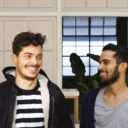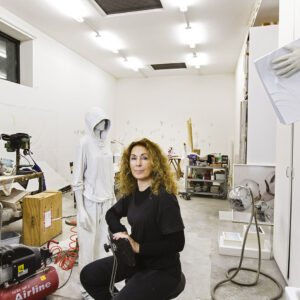«Alfredo Jaar esplora complesse dinamiche sociali e politiche, portando in primo piano l’etica della rappresentazione. Attraverso opere pacate e meditative, Jaar affronta questioni di grande portata, testimoniando disastri umanitari e attestando l’impatto dei conflitti militari, della corruzione politica e della disuguaglianza economica in tutto il mondo. Le sue fotografie, i film, le elaborate installazioni e i suoi progetti basati sul rapporto con le comunità, disturbano provocatoriamente la percezione comune della realtà. Al cuore della sua pratica c’è ciò che Jaar chiama politica delle immagini, la messa in discussione del modo in cui usiamo e consumiamo le immagini, indicando al contempo le limitazioni della fotografia e dei media a rappresentare eventi significativi». Così si legge nelle motivazioni della giuria che ha assegnato all’artista il prestigioso premio Hasselblad per la fotografia 2020.
Tema centrale del suo lavoro è, dunque, la forma della presentazione di problematiche sociali e il modo in cui queste vengono trattate dalla stampa e dalla politica. Jaar mette a nudo i limiti della comunicazione – l’addomesticamento e l’effetto “anestetico” delle immagini che le rende incapaci di trasmettere, e persino di documentare, la natura di un dramma che si è già consumato – e le colpevoli, paradossali contraddizioni non solo di chi produce le informazioni ma anche del pubblico che le rimuove, nella sua impossibilità di vedere la sofferenza, l’orrore o il semplice disagio.
Diversamente dalle immagini di orrore che ci vengono proposte ogni giorno dai media, che esprimono già implicitamente un giudizio e che sembrano non riguardarci direttamente, di fronte alla nostra immagine dietro le sbarre riflessa all’infinito nelle pareti specchianti della cella di Gramsci idealmente ricostruita nella galleria Lia Rumma di Milano nel 2005, per esempio, ci risulta difficile volgere lo sguardo altrove.
Fabrizio Tramontano: Cosa intendevi con “politica delle immagini” e “etica della rappresentazione” a cui ti riferivi quando ti è stato assegnato il premio Hasselblad per la fotografia 2020?
Alfredo Jaar: “Quando ho ricevuto il premio, ho spiegato che per me è stato un grande onore perché ovviamente non sono un fotografo, non mi sono mai considerato un fotografo. Sono interessato a ciò che chiamo ‘la politica delle immagini’ perché le immagini sono molto importanti. Siamo bombardati da milioni di immagini ogni giorno da tutte le fonti, senza preavviso, senza pietà. Queste immagini non solo ci insegnano il mondo, ma influenzano anche il nostro modo di guardarlo, il modo in cui pensiamo. Non sono innocenti. Ogni immagine che vediamo contiene una concezione del mondo ed è quindi fondamentale imparare a leggerle. Nella società contemporanea, nel nostro sistema educativo, non c’è un insegnamento sul ‘vedere’ o sul ‘guardare’ o sull’imparare a come tradurre le immagini. Dovremmo insegnare ai bambini tutte queste cose. Non abbiamo alfabetizzazione visiva nel nostro curriculum scolastico e quindi le immagini sono libere di poter fare dei mostri di tutti noi, poiché non sappiamo come tradurle, come leggerle, come resistergli. Ecco perché io sono affascinato dal potere delle immagini e il mio lavoro riguarda proprio la “politica delle immagini”. Come artista le analizzo e cerco di capirle, e di comunicare al mio pubblico perché sono importanti e come ci stanno condizionando. Ecco perché ero molto commosso quando ho ricevuto quel premio ed ero molto grato che la giuria pensasse che io, nonostante non sia un fotografo, stavo facendo qualcosa di importante per il mondo della fotografia. Quindi sono stato davvero onorato e intimorito da questo premio”.
Qual è l’opera o installazione a te più cara, quella che ritieni esprima meglio il tuo punto di vista sull’arte?
“Mi è stata posta questa domanda molte volte ed è molto difficile, quasi impossibile, dare una risposta. Sono molto critico nei confronti del mio lavoro passato. In realtà sono probabilmente il critico numero uno del mio stesso lavoro. Non vedo l’ora di cominciare il prossimo! Ho sempre considerato tutti i miei lavori come esercizi e come esercizi falliti. Citando Heiner Muller: sono “errori scelti”. Nonostante siano errori, quindi, ho scelto di farli. E ne amo ancora parecchi. Ma non sono in grado di selezionarne uno per te”.
Come cambia il tuo linguaggio in base al progetto su cui stai lavorando?
“Come sai sono un architetto che fa arte e, per me, come architetto che è anche un artista, il contesto è tutto. Ciò significa che quando inizio un nuovo progetto il foglio è bianco e tutto è possibile, perché devo rispondere a un contesto specifico, a un problema specifico, a un pubblico specifico. Creo tutto da zero come reazione al contesto dato”.
Quale sarà il ruolo della memoria in questa tabula rasa che seguirà – che dovrà seguire – l’epidemia?
“La memoria è tutto ciò che abbiamo. E vorrei che avessimo la capacità intellettuale e la volontà di analizzare la memoria, di analizzare la storia e di fare cambiamenti. Perché la memoria è una fantastica lezione di storia, ma purtroppo la società contemporanea non sembra voler imparare né dalla memoria né dalla storia e questo è un problema”.
La situazione in cui siamo sprofondati, potrebbe far nascere finalmente “il nuovo mondo” di cui parla Gramsci nella frase da te utilizzata per la mostra “Napoli, Napoli” alla galleria Lia Rumma nel 2016 e poi per il progetto del Maxxi a Roma “La strada” nel 2019 – e più recentemente a Palermo: “Il vecchio mondo sta morendo. Quello nuovo tarda a comparire. E in questo chiaroscuro nascono i mostri”?
“Sicuramente siamo circondati da mostri. In questo paese con Trump, in Brasile con Bolsonaro, in Europa con Orban e molti altri ancora in tutto il mondo. Quindi è chiaramente il momento dei mostri. È davvero molto difficile emergere per questo “nuovo mondo”. Non so quanti cataclismi dobbiamo ancora attraversare per raggiungerlo e ogni volta che ce n’è uno ho la speranza che ci insegnerà qualcosa, che insegnerà qualcosa al mondo. Ma poi se ne va e nessuno ha imparato niente e torniamo alla vecchia normalità. Forse scompariremo tutti prima che questo nuovo mondo possa emergere. Forse questo nuovo mondo riguarda proprio la nostra scomparsa! Ma, senza dubbio, siamo circondati da mostri. Per me è solo un altro segno che la politica ha tremendamente, miseramente fallito, e che sta a noi creare nuovi modelli di pensare il mondo. Dobbiamo creare un nuovo modello di politica”.
Qual è il tuo rapporto con l’Italia e la cultura italiana di cui hai fatto in tempi diversi un ritratto attraverso le tue mostre e le tue opere?
“Quando la gente mi chiede delle mie influenze come artista, cito sempre Gramsci e Pasolini. Sento di aver sempre lavorato nella loro ombra per molte ragioni. Per essere più precisi, ho scoperto Gramsci durante la dittatura militare in Cile. Fu un’influenza molto importante per la resistenza alla brutalità di Pinochet. È diventato un modello ed è stato attraverso i suoi scritti che ho scoperto la capacità della cultura di indurre il cambiamento. Poco dopo aver scoperto Gramsci, ancora in Cile, ho scoperto Pasolini. Avevo abbandonato gli studi di architettura e mi ero dedicato allo studio del cinema. Quello era il contesto in cui ho visto il mio primo film di Pasolini. Presto ho scoperto che era anche uno scrittore, un poeta, un critico, un polemista, qualcuno immensamente presente nella vita della società italiana ed europea. Molto presto nella mia carriera Pasolini è diventato per me il modello di intellettuale che volevo essere. Ora che sono confinato a casa, già da dieci settimane, sono tornato ai suoi scritti che raccolgo da molti anni. Ieri sera ho letto ancora “Le Ceneri di Gramsci”. È probabilmente uno dei più grandi poemi del 20° secolo. Il mio primo viaggio in Italia è stato nel 1986, quando Achille Bonito Oliva mi invitò alla sezione “Aperto” della Biennale di Venezia. Dopo l’inaugurazione abbiamo fatto un lungo viaggio in giro per l’Italia e visitato così tanti posti. Mi sono innamorato del paese e della sua gente, e ovviamente del cibo. Ho quindi iniziato a lavorare con Lia Rumma, che chiamo “Mamma Rumma”, in omaggio al grande film di Pasolini. Lia è una leggenda, una straordinaria gallerista e un eccezionale essere umano. Faccio mostre con lei da molto tempo. Mio figlio Nicolas si è trasferito in Italia tre anni fa, creando così un legame ancora più forte con questo straordinario Paese. È probabile che un giorno, alla fine, ci trasferiremo anche noi lì”.
Parlami del tuo rapporto con Napoli e di come sei arrivato alla risoluzione concettuale e formale finale della tua mostra “Napoli, Napoli” che hai dedicato alla città nel 2016.
“Come ho detto, sono un architetto che fa arte e per me il contesto è tutto. Quindi, fondamentalmente, cerco di capire il contesto e accumulare il maggior numero di informazioni. Ho sempre detto che non posso agire nel mondo prima di capire il mondo. Questo è il mio modus operandi. Alla fine, quindi, dopo aver accumulato tutte queste informazioni, soprattutto grazie a te e alla tua generosa guida in giro per la città, ho fatto un ritratto di Napoli facendo un riferimento diretto alla “Divina Commedia” di Dante. Ho anche deciso di celebrare Napoli e di rendere un omaggio agli immigrati che hanno trasformato questa città in quello che è oggi. “Napoli, Napoli” è un’installazione con neon che scrive la parola Napoli in tutte le diverse lingue delle più importanti comunità di immigrati della città. “La Divina Commedia” è un’installazione in cui suggerisco che Napoli è il perfetto paesaggio dantesco, dove possiamo trovare contemporaneamente Inferno, Paradiso e Purgatorio. Ho completato una nuova grande installazione permanente in Tasmania, al MONA Museum, intitolata anche questa “La Divina Commedia”. Si compone di tre padiglioni distinti. Per quanto riguarda il mio rapporto con Napoli, adoro la città! Potrei vivere benissimo a Napoli: offre il livello di follia e il caos di cui ho bisogno, oltre a una grandezza incommensurabile di poesia e di bellezza”.
Context is everything!
«Alfredo Jaar explores complex socio-political issues, bringing to the fore the ethics of representation. Through quiet and meditative works, Jaar confronts issues of great magnitude, bearing witness to humanitarian disasters and attesting to the impact of military conflict, political corruption and economic inequality throughout the world. His photographs, films, elaborate installations and community-based projects provocatively disturb common perceptions of reality. At the heart of his practice is what Jaar refers to as the politics of images, questioning the way we use and consume images, while pointing to the limitations of photography and the media to represent significant events». These are the motivations of the jury that awarded the artist the prestigious 2020 Hasselblad prize for photography.
The central theme of his work is, therefore, the form of presentation of social problems, and their treatment by the press and politics. Jaar lays bare their communication limits – the domestication and the “anesthetic” effect of images that are unable to convey, nor to document the nature of a drama that has already taken place – and the guilty, paradoxical contradictions both by those who produce the information, and by a public who cancels it, with its inability to see suffering, horror or the simplest discomfort.
Unlike the horror images that are proposed to us every day by most of the media, and which seem not to concern us directly, since they already implicitly express a judgment, in front of our image behind the bars endlessly reflected in the mirror walls of Gramsci’s cell ideally rebuilt in the Lia Rumma gallery of Milan in 2005 – for example – it is difficult to look away.
Fabrizio Tramontano: What did you mean by “politics of images” and the “ethics of representation” you referred to when you were assigned the Hasselblad prize for photography 2020?
Alfredo Jaar: “When I received the prize I explained that for me it was a huge honor because I am obviously not a photographer, I have never considered myself a photographer. I am interested in what I call “the politics of images” because images are very important. We are bombarded by millions of images every day from all sources without warning, without mercy. These images not only teach us about the world but they also influence the way we look at the world, the way we think. Images are not innocent. Every image that we see contains a conception of the world and so it is fundamental to learn how to read images. In our contemporary society, in our educational system there is no teaching about “seeing” or “looking” or about learning how to translate images. We should teach children all these things. We don’t have visual literacy in our curriculum at school and so images are free to create monsters of all of us because we don’t know how to translate them, how to read them, how to resist them. So that is why I am fascinated by the power of images and my work is about the politics of images. As an artist I analyze images and I try to understand them and communicate to my audience why they are important and what are they doing to us. That is why I was very moved when I received that prize, and I was very thankful that the prize jury thought that even though I am not a photographer, I was still doing something important for the world of photography. So I was truly humbled and honored by this Prize”.
Which is the work or installation that is dearest to you, the one you think best expresses your point of view on art?
“I have been asked this question many times and it is very difficult – quite impossible for me to give an answer. I am very critical of my past work. Actually, I am probably the number one critic of my own work. I can’t wait to start the next one! I have always considered all my works as exercises, and as failed exercises. Quoting Heiner Muller: they are “chosen mistakes”. But, in spite of them being mistakes, I have chosen to make them. And I am still fond of quite a few of them. But I am incapable of selecting one
for you”.
How does your language change according to the project you are working on?
“Well, as you know, I am an architect making art and for me as an architect who is also an artist, context is everything. This means that everything is on the table, everything is a tabula rasa when I start a new project. Because I have to respond to a specific context, to a specific issue, to a specific audience. I create everything from scratch, as a reaction to the given context”.
What will be the role of memory in the post-covid tabula rasa? What will follow – what should follow – the epidemic?
“Well, memory is all we have. And I wish we had the intellectual capacity and the will to analyze memory, to analyze history and to make changes. Because memory is a fantastic history lesson, but unfortunately contemporary society does not seem to want to learn from memory and history and this is a problem”.
Will this situation finally give birth to “the new world” that Gramsci speaks about in the statement you used for your “Napoli, Napoli” exhibition (2016) at the Lia Rumma Gallery and then again for “La strada”, the Maxxi project in Rome (2019) – and more recently in Palermo: “The old world is dying. The new one is slow to appear. And in this chiaroscuro monsters are born”?
“Well, definitely we are surrounded by Monsters. In this country with Trump; in Brazil with Bolsonaro; in Europe you have Orban in Hungary and we have so many others around the world. So, it is clearly a time of monsters. It has been really difficult for this “new world” to emerge. I do not know how many cataclysms we will have to go through before we finally reach this “new world”. Every time there is a cataclysm I hope that it will teach us something, that it will teach the world something. But then it goes away and no one has learned anything and we go back to the old normality. Perhaps we will all disappear before this new world emerges. Maybe that new world is about us disappearing! But definitely we are surrounded by monsters. For me is just another sign that politics has failed us tremendously, miserably, and that we have to create new models of thinking the world. We have to create a new model of politics”.
What is your relationship with Italy and Italian culture – which, at various times, you have depicted in your exhibitions and works?
“When people ask me about my influences as an artist I always mention Gramsci and Pasolini. I feel that I have always worked in the shadow of Gramsci and Pasolini for many reasons. To be more precise I discovered Gramsci during the military dictatorship in Chile. He was a very important influence for the resistance to Pinochet’s brutality. He became a model. And it was through his writings that I discovered the capacity of culture to affect change. Shortly after my discovery of Gramsci, while still in Chile, I discovered Pasolini. I had abandoned my architectural studies and had begun studying filmmaking. That was the context in which I saw my first Pasolini film. Soon I discovered he was also a writer, a poet, a critic, a polemicist, someone who was immensely present in the life of Italian society and European society. Very early in my career Pasolini became the model of intellectual I wanted to be. Now that I am confined at home, and have been for 10 weeks already, I have gone back to his writings that I have collected for many years. Last night I read, again, “Le cenere di Gramsci”. It is probably one of the greatest poems of the 20th century. My first trip to Italy was in 1986 when Achille Bonito Oliva invited me to the “Aperto” section of the Venice Biennale. After the opening we took a long trip around Italy and visited so many places. I completely fell in love with the country and its people, and of course the food. I then started to work with Lia Rumma, whom I call “Mamma Rumma”, in homage, of course, to Pasolini’s great film. Lia is a legend, an extraordinary gallerist, and an exceptional human being. I have shown extensively with her for a long time. Finally, my son Nicolas moved three years ago to Italy, creating another even stronger connection with this extraordinary country. It is likely that one day we will eventually move there too”.
Please tell me about your relationship with Napoli and how you came up with the final conceptual and formal resolution of your “Napoli, Napoli” exhibition that you dedicated
to the city in 2016.
“As I said, I am an architect who makes art. And for me, context is everything. So, I basically try to understand the context and accumulate as much information as possible. I have always said that I cannot act in this world before understanding it. This is my modus operandi. In the end, after accumulating all that information, mostly thanks to you and your generous guidance around the city, I made a portrait of Napoli making direct reference to Dante’s Divine Comedy. I also decided to celebrate Napoli, and pay homage to the immigrants who have transformed Napoli into what it is today. “Napoli, Napoli” is an installation in neon that spells the word Napoli in all the different languages of the most important immigrant communities of the city. “La Divina Commedia” is an installation where I suggest that Napoli is the perfect Dante landscape, and where we can find Inferno, Paradiso and Purgatorio. I completed a new, major permanent installation in Tasmania, at MONA, also titled “The Divine Comedy”. It consists of three distinct pavilions. Regarding my relationship to Napoli, I love this city! I could live perfectly in Napoli, it offers the level of madness and chaos that I need, as well as an immeasurable magnitude of poetry
and beauty”.








No Comments